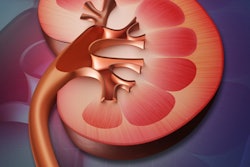A head-to-head comparison of contrast media for coronary CT angiography showed that patients experienced less discomfort after intravenous administration of iodixanol than with iopamidol, according to results presented at the American College of Cardiology (ACC) meeting.
Otherwise, the prospective, multicenter, randomized trial identified no major differences in the agents' relative performances, according to principal investigator Dr. Reza Arsanjani, a cardiologist at Cedars-Sinai Medical Center. The study results were described during a poster session on March 11 at the ACC meeting in San Francisco.
The study involved 266 patients referred for invasive coronary angiography for suspected occlusive coronary artery disease. They were randomly assigned to groups that received coronary CT angiography (CCTA) enhanced with either iodixanol (Visipaque, GE Healthcare) or iopamidol (Isovue, Bracco Diagnostics). X-ray coronary angiography was used as a gold standard.
Previously published safety trials focused on the relative osmolality of iodinated contrast media, such as iso-osmolar iodixanol (290 mOsm/kg) and low-osmolar iopamidol (796 mOsm/kg) and their potential for contrast-induced nephropathy (CIN) in patients with diabetes and other high-risk conditions.
The Patients With Renal Impairment and Diabetes Undergoing Computed Tomography (PREDICT) study by Kuhn et al (American Journal of Roentgenology, July 2008, Vol. 191:1, pp. 151-157) and the Cardiac Angiography in Renally Impaired Patients (CARE) study by Solomon et al (Circulation, June 26, 2007, Vol. 115:25, pp. 3189-3197) showed that the two agents equally restrained CIN to about 4% of patients in high-risk groups.
Meanwhile, a 2006 meta-analysis, also by Solomon and colleagues, concluded that factors other than osmolality influence the pathogenesis of CIN for contrast media having osmolalities less than 800 mOsm/kg (Investigative Radiology, August 2006, Vol. 41:8; pp. 651-660). Iodixanol and iopamidol are both below those thresholds.
Arsanjani's study focused on the relatively high iodine content of iopamidol compared to iodixanol. The distinction had no significant effect on the image quality of CCTA enhanced by the two agents. Based on a five-point Likert scanner, cardiologists determined that 92.5% of the iopamidol-enhanced images and 88% of the iodixanol-enhanced images were good or excellent, but the difference was not statistically significant (p = 0.38)
The clinical efficacy of the CCTA studies in the two arms of the trial was also equivalent. Iopamidol had a slight edge over iodixanol for sensitivity, at 87% versus 79%, but all other measures of accuracy and predictive value for the two agents were greater than 90%.
In terms of patient comfort, patients receiving iopamidol experienced a greater frequency of moderate-to-severe flushing symptoms compared to those who received iodixanol (p = 0.003). Iopamidol patients older than age 55 were especially susceptible (p = 0.015).
Iodixanol's advantage, however, may be negated by a somewhat higher price, Arsanjani said. That difference may be large enough to sway the opinion of cost-conscious physicians.
"But if it were my mom, I would want the less symptomatic agent," he told AuntMinnie.com.
Study disclosure
Several of the co-authors on the study reported they had relationships with medical imaging companies, including GE Healthcare.




















